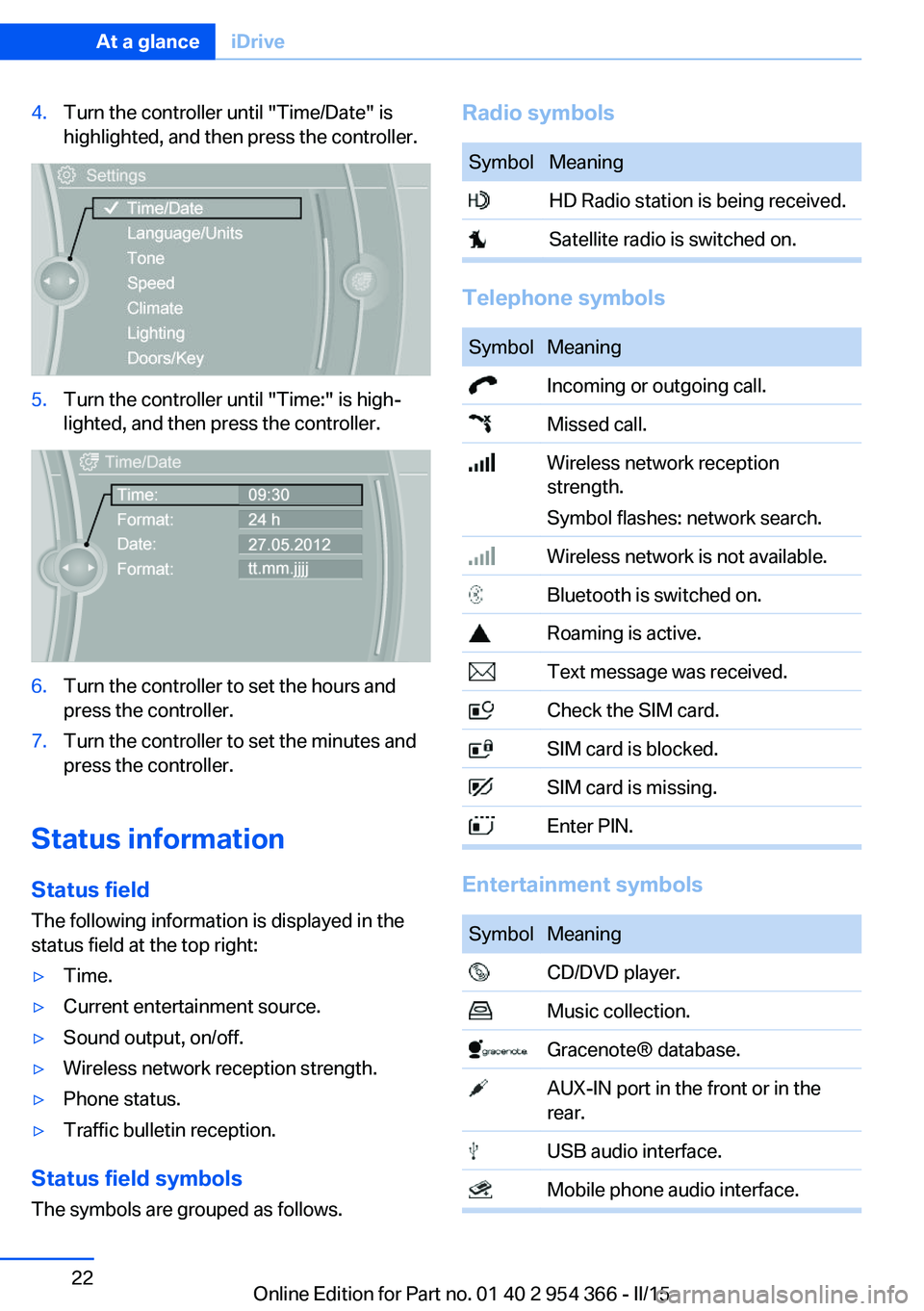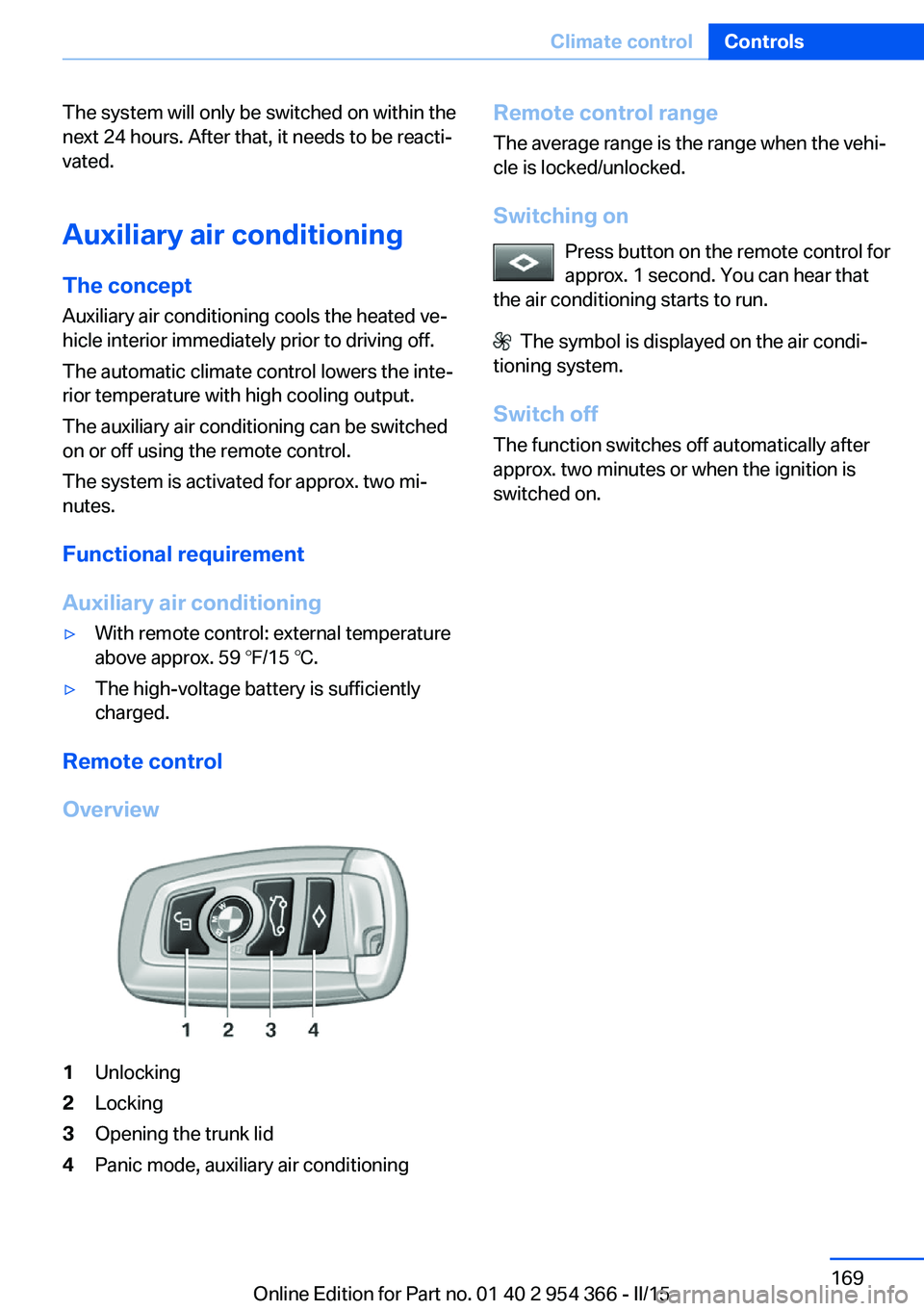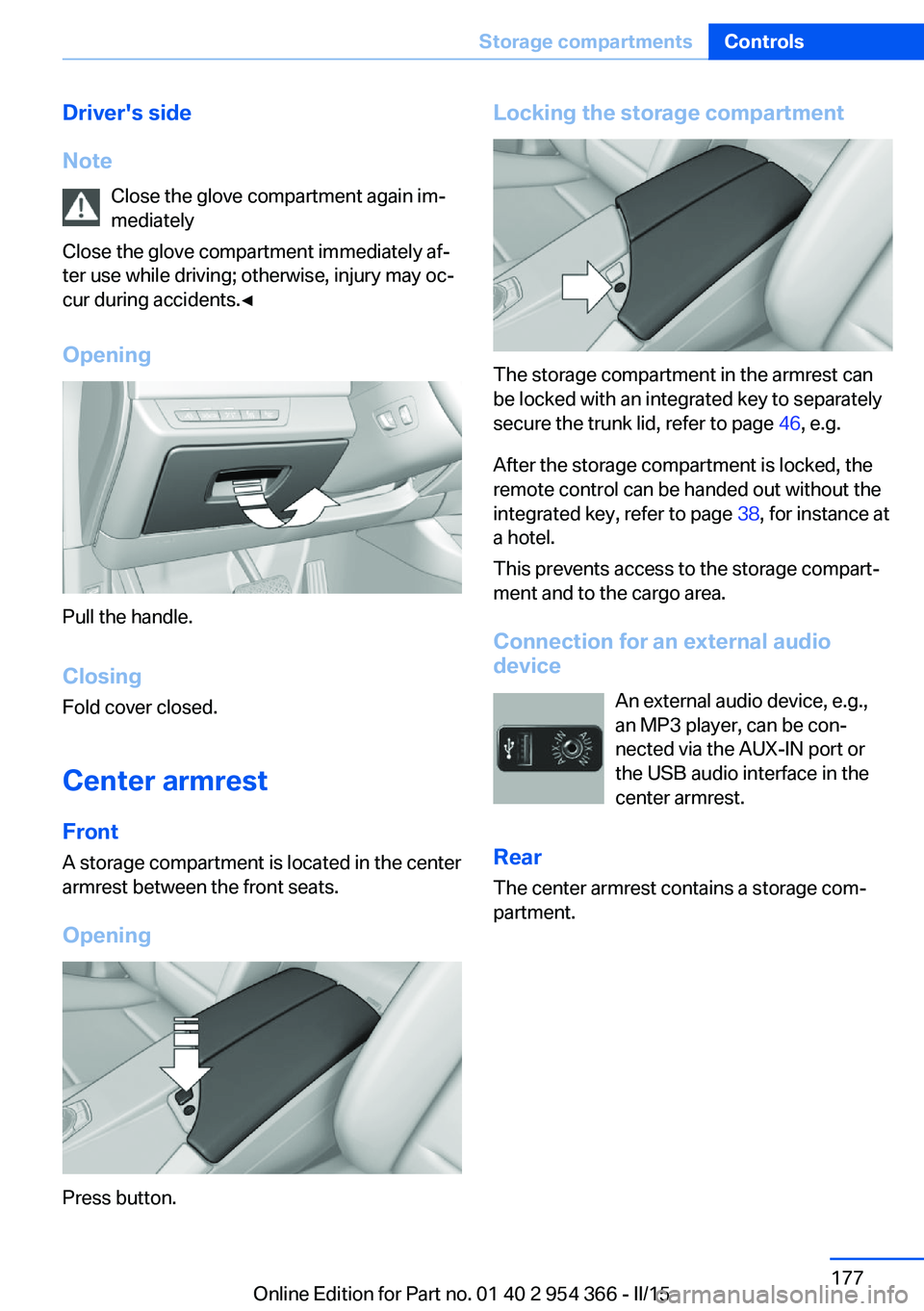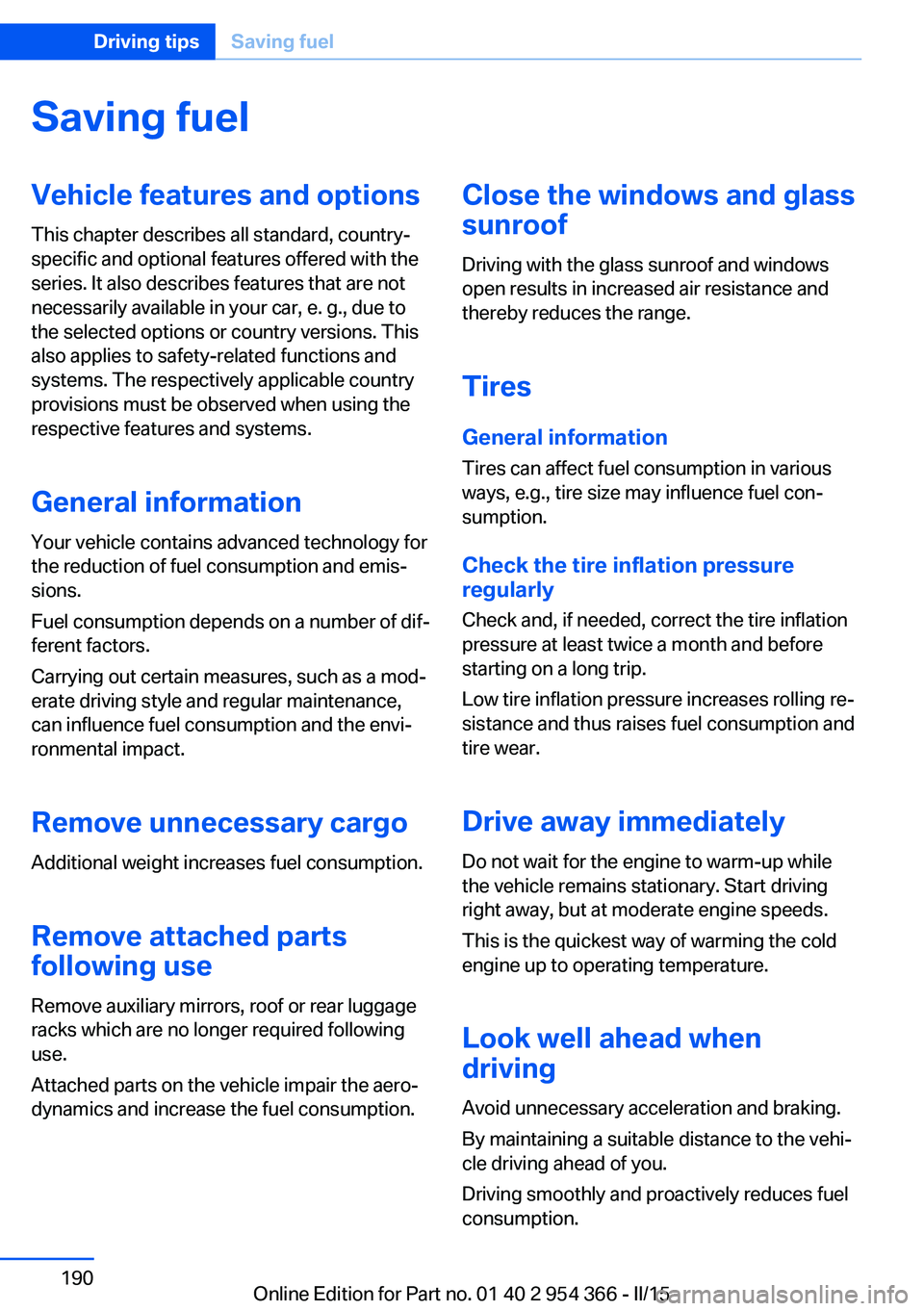AUX BMW 5 SERIES ACTIVE HYBRID 2015 Owners Manual
[x] Cancel search | Manufacturer: BMW, Model Year: 2015, Model line: 5 SERIES ACTIVE HYBRID, Model: BMW 5 SERIES ACTIVE HYBRID 2015Pages: 257, PDF Size: 5.26 MB
Page 26 of 257

4.Turn the controller until "Time/Date" is
highlighted, and then press the controller.5.Turn the controller until "Time:" is high‐
lighted, and then press the controller.6.Turn the controller to set the hours and
press the controller.7.Turn the controller to set the minutes and
press the controller.
Status information
Status field The following information is displayed in the
status field at the top right:
▷Time.▷Current entertainment source.▷Sound output, on/off.▷Wireless network reception strength.▷Phone status.▷Traffic bulletin reception.
Status field symbols
The symbols are grouped as follows.
Radio symbolsSymbolMeaning HD Radio station is being received. Satellite radio is switched on.
Telephone symbols
SymbolMeaning Incoming or outgoing call. Missed call. Wireless network reception
strength.
Symbol flashes: network search. Wireless network is not available. Bluetooth is switched on. Roaming is active. Text message was received. Check the SIM card. SIM card is blocked. SIM card is missing. Enter PIN.
Entertainment symbols
SymbolMeaning CD/DVD player. Music collection. Gracenote® database. AUX-IN port in the front or in the
rear. USB audio interface. Mobile phone audio interface.Seite 22At a glanceiDrive22
Online Edition for Part no. 01 40 2 954 366 - II/15
Page 35 of 257

BMW ActiveHybridVehicle features and options
This chapter describes all standard, country-
specific and optional features offered with the
series. It also describes features that are not
necessarily available in your car, e. g., due to
the selected options or country versions. This
also applies to safety-related functions and
systems. The respectively applicable country
provisions must be observed when using the
respective features and systems.
Hybrid system Special features of the hybrid system
High-voltage system
This BMW is a hybrid vehicle. In addition to the
combustion engine, the vehicle features a
high-voltage system that consists of an elec‐
tric motor and a high-voltage battery among
other things.
Overview1Combustion engine2Electric motor3Control-system electronics, electric motor4High-voltage cables (orange)5High-voltage battery6Auxiliary battery, combustion engine7Starter battery, combustion engine
The conceptThe hybrid system makes it possible to opti‐
mize fuel consumption and driving characteris‐
tics.
An electric motor assists the combustion en‐
gine. In certain driving situations, the vehicle
can also be driven using only electric power,
thereby reducing fuel consumption.
In addition to this, the electric motor acts like
an alternator: during braking and coasting, it
converts the vehicle's kinetic energy into elec‐ tricity. The current is stored in the high-voltage
battery and is used to drive the electric motor.
Functions
Electric driving: eDRIVE Under certain conditions, refer to page 76,
the vehicle is powered only by the electric mo‐
tor.
Acceleration boost Driving off and accelerating require a lot of en‐
ergy.
To optimize acceleration and to reduce fuel
consumption, the electric motor boosts the
combustion engine, refer to page 77. To do
this, the electric motor uses the energy saved
in the high-voltage battery.
Auto Start/Stop function The Auto Start/Stop function, refer to
page 75, switches the combustion engine off
when coasting, braking and while the vehicle is
stopped. Convenience functions such as the
automatic climate control are supplied by the
Seite 31BMW ActiveHybridAt a glance31
Online Edition for Part no. 01 40 2 954 366 - II/15
Page 36 of 257

high-voltage battery and can remain switched
on.
Driving with combustion engine:
DRIVE
The combustion engine, refer to page 77,
provides the primary performance to move the
vehicle. If necessary, the high-voltage battery is charged at the same time.
The hybrid system always starts the combus‐
tion engine automatically.
Energy recovery: CHARGE The high-voltage battery of the hybrid system
is charged through energy recovery while driv‐
ing.
The electric motor acts as a generator and
converts the kinetic energy of the vehicle into
electric current.
Charging can take place in various situations:▷When the vehicle is coasting if the acceler‐
ator pedal is not pressed.▷During vehicle braking.
When exerting gentle pressure on the brakes,
the vehicle is only braked by the electric motor.
When the brake pedal is depressed further, the
brake system is activated additionally. This is
why only part of the brake energy is used to
charge the high-voltage battery when exerting
firm pressure on the brake.
Foresighted driving and the early reduction of
speed are important to make full use of the hy‐
brid characteristics of the vehicle.
Coasting The engine is automatically switched off. This
driving condition of rolling is referred to as
coasting, refer to page 76.
Auxiliary functions of the automatic
climate control
The hybrid system makes it possible to oper‐
ate the automatic climate control prior to driv‐
ing off and with the combustion engine
switched off.
Using the auxiliary air conditioning and residual
cooling functions, the vehicle interior can be
cooled immediately prior to departure and if
the trip is interrupted.▷Residual cooling, refer to page 168.▷Auxiliary air conditioning, refer to
page 169
Adapting to the course of the road
When the navigation system destination guid‐
ance is active, the hybrid system uses the ex‐
isting navigation data. Hybrid operation adapts
to the specific route sections. These may be:
▷Steep gradients.▷Arrival in the destination zone.
Pay attention to the notes in Adapting to the
course of the road, refer to page 90.
Display
The displays of the hybrid system, refer to
page 88, provide information about the cur‐
rent state of hybrid operation and show the
system activity in a chart.
Energy-saving driving To save energy while driving, read the follow‐
ing information:
▷Saving fuel, refer to page 190.▷Using the hybrid system efficiently, refer to
page 182▷ECO PRO mode, refer to page 191.▷Adapting to the course of the road, refer to
page 90.
Safety information
Read the information on safe handling of the
high-voltage system, refer to page 34.
Seite 32At a glanceBMW ActiveHybrid32
Online Edition for Part no. 01 40 2 954 366 - II/15
Page 42 of 257

Opening and closingVehicle features and options
This chapter describes all standard, country-
specific and optional features offered with the
series. It also describes features that are not
necessarily available in your car, e. g., due to
the selected options or country versions. This
also applies to safety-related functions and
systems. The respectively applicable country
provisions must be observed when using the
respective features and systems.
Remote control/key General information
The vehicle is supplied with two remote con‐
trols with integrated key.
Every remote control holds a replaceable bat‐
tery.
You may set the key functions depending on
the optional features and country-specific ver‐
sion. For Settings, refer to page 50.
The vehicle stores personal settings for every
remote control. Personal Profile, refer to
page 39.
The remote controls hold information on re‐
quired maintenance. Service data in the re‐
mote control, refer to page 218Overview1Unlocking2Locking3Opening the trunk lid
With automatic tailgate operation: opening
the trunk lid4Function adjustable:
Panic mode in alarm system, auxiliary air
conditioning, headlamp courtesy delay fea‐
ture
Integrated key
Press button, arrow 1, and remove the key, ar‐
row 2.
The integrated key fits the following locks:
▷Driver's door.▷Storage compartment in the front center
armrest.Seite 38ControlsOpening and closing38
Online Edition for Part no. 01 40 2 954 366 - II/15
Page 173 of 257

The system will only be switched on within the
next 24 hours. After that, it needs to be reacti‐
vated.
Auxiliary air conditioning
The concept Auxiliary air conditioning cools the heated ve‐
hicle interior immediately prior to driving off.
The automatic climate control lowers the inte‐
rior temperature with high cooling output.
The auxiliary air conditioning can be switched
on or off using the remote control.
The system is activated for approx. two mi‐
nutes.
Functional requirement
Auxiliary air conditioning▷With remote control: external temperature
above approx. 59 ℉/15 ℃.▷The high-voltage battery is sufficiently
charged.
Remote control
Overview
1Unlocking2Locking3Opening the trunk lid4Panic mode, auxiliary air conditioningRemote control range The average range is the range when the vehi‐
cle is locked/unlocked.
Switching on Press button on the remote control for
approx. 1 second. You can hear that
the air conditioning starts to run.
The symbol is displayed on the air condi‐
tioning system.
Switch off
The function switches off automatically after
approx. two minutes or when the ignition is
switched on.
Seite 169Climate controlControls169
Online Edition for Part no. 01 40 2 954 366 - II/15
Page 181 of 257

Driver's side
Note Close the glove compartment again im‐
mediately
Close the glove compartment immediately af‐
ter use while driving; otherwise, injury may oc‐
cur during accidents.◀
Opening
Pull the handle.
ClosingFold cover closed.
Center armrest
Front
A storage compartment is located in the center
armrest between the front seats.
Opening
Press button.
Locking the storage compartment
The storage compartment in the armrest can
be locked with an integrated key to separately
secure the trunk lid, refer to page 46, e.g.
After the storage compartment is locked, the
remote control can be handed out without the
integrated key, refer to page 38, for instance at
a hotel.
This prevents access to the storage compart‐
ment and to the cargo area.
Connection for an external audio
device
An external audio device, e.g.,
an MP3 player, can be con‐
nected via the AUX-IN port or
the USB audio interface in the center armrest.
Rear
The center armrest contains a storage com‐
partment.
Seite 177Storage compartmentsControls177
Online Edition for Part no. 01 40 2 954 366 - II/15
Page 194 of 257

Saving fuelVehicle features and optionsThis chapter describes all standard, country-
specific and optional features offered with the
series. It also describes features that are not
necessarily available in your car, e. g., due to
the selected options or country versions. This
also applies to safety-related functions and
systems. The respectively applicable country
provisions must be observed when using the
respective features and systems.
General information Your vehicle contains advanced technology for
the reduction of fuel consumption and emis‐
sions.
Fuel consumption depends on a number of dif‐
ferent factors.
Carrying out certain measures, such as a mod‐
erate driving style and regular maintenance,
can influence fuel consumption and the envi‐
ronmental impact.
Remove unnecessary cargo
Additional weight increases fuel consumption.
Remove attached parts
following use
Remove auxiliary mirrors, roof or rear luggage
racks which are no longer required following use.
Attached parts on the vehicle impair the aero‐
dynamics and increase the fuel consumption.Close the windows and glass
sunroof
Driving with the glass sunroof and windows
open results in increased air resistance and
thereby reduces the range.
Tires
General information Tires can affect fuel consumption in various
ways, e.g., tire size may influence fuel con‐
sumption.
Check the tire inflation pressure
regularly
Check and, if needed, correct the tire inflation
pressure at least twice a month and before
starting on a long trip.
Low tire inflation pressure increases rolling re‐
sistance and thus raises fuel consumption and
tire wear.
Drive away immediately
Do not wait for the engine to warm-up while
the vehicle remains stationary. Start driving
right away, but at moderate engine speeds.
This is the quickest way of warming the cold
engine up to operating temperature.
Look well ahead when
driving
Avoid unnecessary acceleration and braking.
By maintaining a suitable distance to the vehi‐
cle driving ahead of you.
Driving smoothly and proactively reduces fuel
consumption.Seite 190Driving tipsSaving fuel190
Online Edition for Part no. 01 40 2 954 366 - II/15
Page 246 of 257

Everything from A to Z
IndexA ABS, Antilock Brake Sys‐ tem 136
ACC, Active Cruise Control with Stop & Go 141
Accessories and parts 7
Activated-charcoal filter 165
Activate drive readiness 74
Active Blind Spot Detec‐ tion 131
Active Cruise Control with Stop & Go, ACC 141
ActiveHybrid, system 31
Active Protection 133
Active seat, front 60
Active seat ventilation, front 61
Adapting to the course of the road, hybrid system 90
Adaptive brake assistant 136
Adaptive brake lights, refer to Brake force display 133
Adaptive Light Control 105
Additives, oil 214
Adjustments, seats/head re‐ straints 57
After washing vehicle 234
Airbags 109
Airbags, indicator/warning light 110
Air circulation, refer to Recir‐ culated-air mode 164
Air, dehumidifying, refer to Cooling function 164
Air distribution, manual 163
Air flow, automatic climate control 163
Air outlets, see ventila‐ tion 165
Air pressure, tires 200 Alarm system 51
Alarm, unintentional 52
All around the center con‐ sole 16
All around the roofliner 17
All around the steering wheel 14
All-season tires, refer to Win‐ ter tires 206
Alternating-code hand-held transmitter 171
Alternative oil types 215
Ambient light 108
Animal detection, see Night Vision 127
Antifreeze, washer fluid 83
Antilock Brake System, ABS 136
Anti-slip control, refer to DSC 136
Approved axle load 241
Approved engine oils, see Suitable engine oil
types 215
Armrest, refer to Center arm‐ rest 177
Arrival time 99
Ashtray 172
Ashtray, front 172
Ashtray, rear 173
Assistance for the combus‐ tion engine, ASSIST 77
Assistance for the combus‐ tion engine, eBOOST 77
Assistance when driving off 136
ASSIST, assistance for the combustion engine 77
Attentiveness assistant 133
AUTO H button 78 AUTO H button, refer to Au‐
tomatic Hold 78
AUTO intensity 163
Automatic car wash 233
Automatic climate con‐ trol 162
Automatic Cruise Control with Stop & Go 141
Automatic Curb Monitor 66
Automatic deactivation, front- seat passenger airbags 111
Automatic deactivation of the hybrid system 34
Automatic headlight con‐ trol 105
Automatic Hold 78
Automatic locking 50
Automatic recirculated-air control 164
Automatic Soft Closing, doors 44
Automatic transmission, see Steptronic transmission 83
Automatic trunk lid 45
AUTO program, automatic cli‐ mate control 163
AUTO program, intensity 163
Auto Start/Stop function 75
Auxiliary air conditioning 169
Average fuel consumption 99
Average speed 99
Axle loads, weights 241
B Backrest curvature, refer to Lumbar support 59
Backrest, width 59
Band-aids, refer to First aid kit 228 Seite 242ReferenceEverything from A to Z242
Online Edition for Part no. 01 40 2 954 366 - II/15
Page 253 of 257

Recommended fuelgrade 198
Recommended tire brands 205
Refueling 196
Remaining range 95
Remote control/key 38
Remote control, auxiliary air conditioning, key 169
Remote control, malfunc‐ tion 42
Remote control, univer‐ sal 170
Replacement fuse 226
Replacing parts 220
Replacing wheels/tires 205
Reporting safety defects 10
RES button 144
RES button, see Active Cruise Control, ACC 141
RES button, see Cruise con‐ trol 148
Reserve warning, refer to Range 95
Reset, Tire Pressure Monitor TPM 113
Residual cooling 168
Residual heat, automatic cli‐ mate control 165
Retaining straps, securing cargo 188
Retreaded tires 205
Reversing lamp, bulb replace‐ ment 224
Roadside parking lights 105
Roller sunblinds 53
RON recommended fuel grade 198
Roofliner 17
Roof load capacity 241
Roof-mounted luggage rack 188
Rope for tow-starting/ towing 230 RSC Run Flat System Com‐
ponent, refer to Run-flat
tires 206
Rubber components, care 235
Run-flat tires 206
S Safe braking 185
Safety 7
Safety belt reminder for driv‐ er's seat and front passen‐
ger seat 62
Safety belts 61
Safety belts, care 235
Safety of the high-voltage system 34
Safety Package, refer to Ac‐ tive Protection 133
Safety switch, windows 53
Safety systems, airbags 109
Saving fuel 190
Screen, refer to Control Dis‐ play 18
Screwdriver, see Onboard ve‐ hicle tool kit 220
Screw thread, refer to Screw thread for tow fitting, screw
thread for tow fitting 231
Sealant 206
Seat belts, refer to Safety belts 61
Seat heating, front 60
Seat heating, rear 60
Seating position for chil‐ dren 69
Seat, mirror, and steering wheel memory 65
Seats 57
Seat ventilation, front 61
Selection list in instrument cluster 98
Selector lever, Steptronic transmission 84
Sensors, care 236 Service and warranty 8
Service requirements, Condi‐ tion Based Service
CBS 218
Service requirements, dis‐ play 95
Services, ConnectedDrive
SET button, see Active Cruise Control, ACC 141
SET button, see Cruise con‐ trol 148
Settings, locking/unlock‐ ing 50
Settings on Control Dis‐ play 101
Settings, storing for seat, mir‐ rors, steering wheel 65
Shift paddles on the steering wheel 85
Shoulder support 60
Side airbags 109
Side View 155
Signaling, horn 14
Signals when unlocking 50
Silent Start, electric drive readiness 74
Sitting safely 57
Size 240
Slide/tilt glass roof 54
Smallest turning radius 240
Smoker's package 172
Snow chains 210
Socket 173
Socket, OBD Onboard Diag‐ nostics 219
SOS button 227
Spare fuse 226
Speaker lighting 108
Specified engine oil types 215
Speed, average 99
Speed limit detection, on- board computer 99
Speed limiter, display 96
Speed Limit Information 96
Speed warning 100 Seite 249Everything from A to ZReference249
Online Edition for Part no. 01 40 2 954 366 - II/15